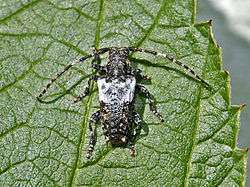Pogonocherus hispidulus
| Pogonocherus hispidulus | |
|---|---|
 | |
| Pogonocherus hispidulus | |
| Scientific classification | |
| Kingdom: | Animalia |
| Phylum: | Arthropoda |
| Class: | Insecta |
| Order: | Coleoptera |
| Suborder: | Polyphaga |
| Family: | Cerambycidae |
| Genus: | Pogonocherus |
| Species: | P. hispidulus |
| Binomial name | |
| Pogonocherus hispidulus (Piller & Mitterpacher, 1783) | |
| Synonyms | |
| |
Pogonocherus hispidulus, the Greater Thorn-tipped Longhorn Beetle, is a species of flat-faced longhorns beetle in the family Cerambycidae.
Description
Pogonocherus hispidulus can reach a length of 5–8 millimetres (0.20–0.31 in). The basic color of the body is gray-black, with a wide whitish transverse band on scutellum. It has white marked antennae and a long teeth at the apex of each elytron. Adults can be found from April until August. The larvae are polyphagous, feeding in deciduous trees on small dead branches and dead twigs. The development usually takes two years.
Distribution
This beetle is present in most of Europe, in Caucasus, Russia, the Near East and in Turkey.
Habitat
This species lives on deciduous trees and shrubs.
References
External links
This article is issued from Wikipedia - version of the 6/1/2016. The text is available under the Creative Commons Attribution/Share Alike but additional terms may apply for the media files.